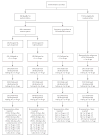Developmental outcomes after early or delayed insertion of tympanostomy tubes
- PMID: 16093466
- PMCID: PMC1201478
- DOI: 10.1056/NEJMoa050406
Developmental outcomes after early or delayed insertion of tympanostomy tubes
Abstract
Background: To prevent later developmental impairments, myringotomy with the insertion of tympanostomy tubes has often been undertaken in young children who have persistent otitis media with effusion. We previously reported that prompt as compared with delayed insertion of tympanostomy tubes in children with persistent effusion who were younger than three years of age did not result in improved developmental outcomes at three or four years of age. However, the effect on the outcomes of school-age children is unknown.
Methods: We enrolled 6350 healthy infants younger than 62 days of age and evaluated them regularly for middle-ear effusion. Before three years of age, 429 children with persistent middle-ear effusion were randomly assigned to have tympanostomy tubes inserted either promptly or up to nine months later if effusion persisted. We assessed developmental outcomes in 395 of these children at six years of age.
Results: At six years of age, 85 percent of children in the early-treatment group and 41 percent in the delayed-treatment group had received tympanostomy tubes. There were no significant differences in mean (+/-SD) scores favoring early versus delayed treatment on any of 30 measures, including the Wechsler Full-Scale Intelligence Quotient (98+/-13 vs. 98+/-14); Number of Different Words test, a measure of word diversity (183+/-36 vs. 175+/-36); Percentage of Consonants Correct-Revised test, a measure of speech-sound production (96+/-2 vs. 96+/-3); the SCAN test, a measure of central auditory processing (95+/-15 vs. 96+/-14); and several measures of behavior and emotion.
Conclusions: In otherwise healthy children younger than three years of age who have persistent middle-ear effusion within the duration of effusion that we studied, prompt insertion of tympanostomy tubes does not improve developmental outcomes at six years of age.
Copyright 2005 Massachusetts Medical Society.
Figures

Comment in
-
Tympanostomy tubes do not improve developmental outcomes.J Pediatr. 2006 Jan;148(1):144. doi: 10.1016/j.jpeds.2005.12.007. J Pediatr. 2006. PMID: 16440483 No abstract available.
References
-
- Schappert SM. Ambulatory care visits to physician offices, hospital outpatient departments, and emergency departments: United States, 1997. Vital Health Stat. 1999;143:13–37. - PubMed
-
- Owings MF, Kozak LJ. Ambulatory and inpatient procedures in the United States, 1996. Vital Health Stat. 1998;139:19. - PubMed
-
- Stool SE, Berg AO, Berman S, et al. Otitis media with effusion in young children: clinical practice guideline no. 12. Rockville, Md.: Agency for Healthcare Policy and Research, July 1994. (AHCPR publication no. 94-0622.)
-
- American Speech–Language–Hearing Association. Guidelines for acoustic immitance screening of middle-ear function. ASHA. 1979;21:283–8.
-
- American Academy of Pediatrics Joint Committee on Infant Hearing. . Joint Committee on Infant Hearing 1994 position statement. Pediatrics. 1995;95:152–6. - PubMed
Publication types
MeSH terms
Grants and funding
- M01RR00084/RR/NCRR NIH HHS/United States
- R01 HD042080-01/HD/NICHD NIH HHS/United States
- R01 HD026026-10A2S1/HD/NICHD NIH HHS/United States
- R01 HD042080-03/HD/NICHD NIH HHS/United States
- R01 HD026026-08/HD/NICHD NIH HHS/United States
- R01 HD026026-09S1/HD/NICHD NIH HHS/United States
- R01 HD042080-02/HD/NICHD NIH HHS/United States
- R01 HD042080/HD/NICHD NIH HHS/United States
- HD26026/HD/NICHD NIH HHS/United States
- R01 HD026026-09/HD/NICHD NIH HHS/United States
- R01 HD026026-10A2/HD/NICHD NIH HHS/United States
- M01 RR000084/RR/NCRR NIH HHS/United States
- HD42080/HD/NICHD NIH HHS/United States
- R01 HD026026-09S2/HD/NICHD NIH HHS/United States
